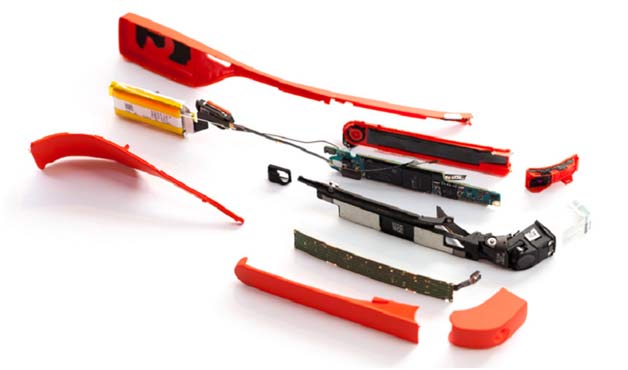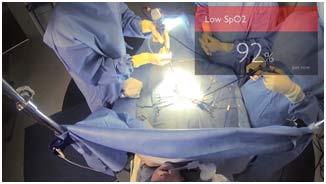“Machines are made to do what man can never do. Well, guess who makes the machines?

Figure 1: Representational image of a Google Glass
We all imagined what the future would be like in our childhood, imagining quite intense technologies, such as flying cars, houses floating in the air, holographic phones, etc. But we look at the world now and see these ideas really coming to life. One such device is Google’s latest project, “ Google glasses ”. What is Google Glass? What do you promise to do? What are its salient features? We'll discover all this and more as we go along.
In simple terms, Google Glass is a computer that you can wear on your head in the same way you would wear a set of glasses, which comes with a Head Mounted Optical Display ( Ohmd ) working on a class of technology called “ Augmented Reality ”. Therefore, the display of this device is visible in the front (top right) of your view through a prism projector lens. It has most of the features of a modern smartphone. It is controlled by voice command and can take photos and record videos of what you see. It was developed by GoogleX (still in the beta testing phase), a special sector of Google responsible for developing futuristic technologies. Google X is also responsible for developing the driverless car.
Check what it looks like through Google Glass.
Technical specifications

Figure 2: Google Glass technical specifications
Google Glass runs on Android (version 4.0.4 'IceCream Sandwich' or higher), which is an open source operating system (owned by Google Inc.) used in many of today's smartphones. The Android operating system allows developers to create program applications that utilize the various hardware and software features built into the glass. It provides space for customizations to be applied to the device.
It has a 5 megapixel camera that can record videos in 720p HD resolution with a simple voice command or a tap on the side touchpad. The camera is very similar to those used in smartphones.
A 640×360 resolution display powered by a prismatic projector is used. According to Google, this resolution in relation to size is equivalent to watching a 25-inch high-definition screen from two and a half meters away. The display unit is also located on a flexible PCB (printed circuit board) which contains sensors like InvenSense MPU-9150 (which is a glass inertial sensor), Wolfson WM7231 MEMS microphone, there is an additional microphone on the main board which will probably work as a noise canceling device.
A lithium polymer rechargeable battery with 560mAh capacity provides one day of use with typical use. The battery unit is provided in the rear section of the case to structurally balance the front load of the optical module and CPU board. The battery is NOT user replaceable.
The CPU main board located in the heart of the control box. On the PCB (Printed Circuit Board) are the main processors, 16 GB SanDisk flash drive module, Wi-Fi and Bluetooth module, Elpida mobile DRAM chipset along with some RF devices. There is an onboard 16GB of internal storage, of which 12GB is available to the user. Glass also syncs with your online Google Drive account to store photos and videos. 1GB RAM of which 628 MB is available for app use.
There is a Bluetooth and Wi-Fi unit built into the main circuit of the CPU. There is no GPS on board, but it can be paired with an Android smartphone to activate Google Maps.
Google Glass also has a touchpad on the side of the optical bearing arm, providing touch input. It can be swiped back and forth to switch between the interface's various screens in a timeline-like layout. The touchpad was developed by Sináptica driven by a Synaptics T1320A touchpad controller, which is an interface between software and hardware.
The sound is transferred through a relatively new technology called “Bone Conduction Transfer ” that vibrates your skull and signals the eardrum, making it nearly inaudible to those around the user. The bone conduction speaker also works as a tactile switch.
The glass is also controlled by voice commands , through the microphone. The device is activated by the user tilting the head upwards 30 ° (can be changed). Additionally, it can also be activated by tapping the touchpad and saying “OK, Glass”. The camera is controlled by saying “Take a photo” or “Record a video”. Many other functions, such as Google searches, email, directions and Android apps, can be controlled by voice.

Figure 3: Google Glass Mini Projector
Following are the expected technical specifications of Google Glass
Operating system : Android (4.0.4 and above).
CPU: Texas Instruments 1.2 GHz Dual Core Processor
Internal storage : 16 Giga Byte Sandisk flash drive.
Memory: 1 gigabyte of RAM.
Power: Lithium polymer battery (560mAh).
Sound: Bone conduction transducer.
Show: Display projected on a prism with a resolution of 640×360 pixels.
Camera: 5 Megapixels with 720p recording capacity.
Sensors: Proximity, Ambient light, Magnetometer, Microphone, Gyroscope, Accelerometer, Touchpad.
Connectivity: Bluetooth, Wi-Fi 802.11b/g, Micro USB.
Weight: 50 grams.
Currently, Google Glass has only released a beta device available to a select number of individuals (developers and explorers) priced at $1,500 (approximately INR 90,000). The consumer version is also expected to be available at a much lower price (roughly the cost of an IPhone), subsidizing the success of the Nexus 7.
Project
Google Glasses are designed to be lightweight and completely unobtrusive (thanks to the titanium frame). It has an extremely robust body with a structure that comes with additional cushions for greater comfort. It has a touchpad along one of the arms for interaction. The current Explorer version does not provide for the attachment of prescription lenses if you already wear glasses, but the consumer version promises the integration of prescription lenses into the Glass frame. Google Glass is currently expected to come out in five colors; Coal (black), Tangerine (orange), Shale (gray), Sky (blue) and Cotton (white).

Figure 4: Colors available on Google Glass
Uses of Google Glass
Where and how can it be used?
Google Glasses is a device that can be used in various fields. Finding the uses of Google Glass would be an operations research project in itself. Thanks to the open source nature of Android (basically programming through Java), it allows third-party developers to create their own applications, which expands the scope of innovation.
For personal use, it can be used as a great tool for travel, business, social media and amateur photography. Of course, all of this can be done on a smartphone, so why use Google Glass? One answer would be that you don't need to just focus on the device while operating it. It is completely hands-free, allowing the user to enjoy the privilege of operating it anywhere. You see a memorable moment that you want to capture, but the moment has already passed by the time you pull out your camera or smartphone, but if you have Google Glass the moment is captured with a simple three words. You can capture memories as you see them, just like saving your memories to a hard drive. This is just a small part of the wide range of applications such as flight reminders, Evernote, Google search on the go, assisted navigation, language translation and more.
In industry, Google Glass can be used to increase productivity. A worker's performance can be recorded and reviewed to study areas for improvement or to maintain a database. Technicians can receive guided instructions or identify faults in a system. A small solar installation company in the USA, “Sullivan Solar Power” has recognized the revolutionary power of Google Glass. They organized brainstorming events to identify the range of applications for glass to increase productivity. Programmers with no experience in mobile app development were able to produce a workflow and app in a few months by testing it on a unit that was purchased from eBay (global e-commerce site).
The applications of this device in healthcare greatly increase the efficiency of surgeries. This was first studied by LuceinEngelen, a European healthcare professional who was invited to the explorer program by Google. He has conducted research on glass in operating rooms, ambulances, trauma helicopters, home care, and as an aid to teaching students through video interactions (phone consultation) on Google Hangouts. Recently in India in January 2014, a US-based orthopedic surgeon, Dr. Selen G. Parekh, performed foot and ankle surgery using Google Glass. This operation was broadcast live by Google during an Indo-US national conference. It was claimed that it was useful to observe the patient's X-ray or MRI (magnetic resonance image) without taking one's eyes off the patient. Recorded video can provide efficient teaching aid for students and professionals.

Figure 5: Image showing the use of Google Glass in the medical field
Where are you going?
This is a technology that is beyond its time. It provoked a revolution among the public, raising certain legal and privacy concerns. People don't like the idea of having private conservation knowing that there is an additional perspective on the picture. Google Glass has already been banned in certain locations that contain sensitive business information. For users, security is a major concern if the device is stolen, which can lead to hacking of private information. Google is working on security measures to disable a stolen device through an online interface. In short, it will take a few years for this new market to establish itself.
Google Google faces stiff competition from its rivals, Apple and Microsoft, who are working on similar products. Samsung is also rumored to be working on a more modern and affordable version of the glass. Ultimately, the leaders, Google Inc., have big plans for Google Glass as a mass consumer product at the turn of the decade.
The Consumer version of Glass will soon be available in Google stores later this year (around May 2014) at a lower price and with possible provisions for lens attachment.

